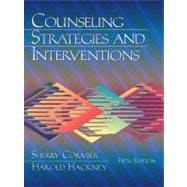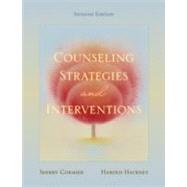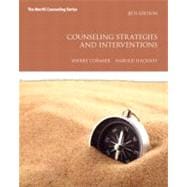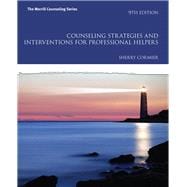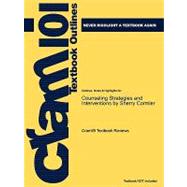Counseling Strategies and Interventions

Counseling Strategies and Interventions
- ISBN 13:
9780205370528
- ISBN 10:
0205370527
- Edition: 6th
- Format: Paperback
- Copyright: 01/01/2008
- Publisher: Allyn & Bacon
- Newer Edition
Rent
Sorry, this item is currently unavailable.
Note: Supplemental materials are not guaranteed with Rental or Used book purchases.
Extend or Purchase Your Rental at Any Time
Need to keep your rental past your due date? At any time before your due date you can extend or purchase your rental through your account.
Summary
MT, 11/14/2003, coded; ISBN: 0-205-37052-7 Priority: B Discount Code: K Previous Edition ISBN: 0-205-29347-6 Counseling Strategies and Interventions, 6/e Sherry Cormier West Virginia University Harold Hackney Fairfield University Publication Data: 2005, 7 x 9 1/4, Paper, 224 pp Course codes: SE1203 Counseling Interventions SP0425 Strategies in Counseling and Psychotherapy SE1229 Counseling Process, Skills, and Techniques Appropriate Courses Designed for upper-level undergraduate and entry-level masters courses in strategies in counseling, process, skills, and techniques, and intervention offered in the Departments of Counseling and Psychology. Summary Counseling Strategies and Interventions, Sixth Edition, prepares students for the real world of counseling people in today''s global society from an integrative perspective. This highly readable, pragmatic text focuses on basic counseling skills and strategies within a multicultural context, providing a solid introduction to the helping process and the counseling profession. Concise and current, it discusses up-to-date issues, such as diversity and multiculturalism, throughout. The authors provide a unique focus on the student''s growth and development as a counselor and how the student can best use supervision in this developmental process. Features Practical exercises and discussion questions interspersed throughout the text provide students with opportunities to practice and apply the skills and strategies presented in each chapter. Each chapter provides several examples, vignettes, and client cases designed to model and illustrate the chapter''s key concepts and skills. Highly readable and easy-to-grasp content help students translate simple ideas into more complex and global models as each chapter progresses., allowing readers to easily outline objectives and goals. Provides a unique focus on the student''s growth and development as a counselor (Ch. 11). Material on diversity and multicultural counseling enlightens students on such subtopics as specialties in counseling, trends in counseling including spirituality, cultural competence, relational and cultural empathy, cultural and gender factors, and working with different client social systems. Discussion of credentialing and licensing of counselors gives students real-world perspectives (Ch. 1). New To This Edition "Application Exercises" interspersed throughout each chapter allow students to apply content and obtain feedback, helping to reinforce major chapter concepts. Features new content and available resources on professional identity, credentialing of professional helpers and professional organizations, and standards of practice to assist students in delineating the evolution of the helping profession (Ch.1 & Appendix A). A brand new chapter, "Common Challenges for Beginning Counselors," addresses the concerns, challenges, and ethical boundaries of beginning helpers (Ch. 10). Includes newly revised material on cultural competence, power, privilege, and social justice throughout (Chs. 1-9). Incorporates bold new discussions on current ethical issues addressed in the workplace and how to structure the counseling session around those issues (Ch. 5). Expanded dialogue of contextual, cultural, and nonverbal affect cues; building a positive client relationship utilizing the Prochaska, DiClemente, and Norcross Stages of Change model; and integrative counseling strategies augment the helper''s awareness of pitfalls in helping. Contents Each chapter concludes with "Summary," "Discussion Questions," and "Recommended Readings." Exercises. Preface. 1. The Helping Profession. What Is Helping? Setting in Which Counselors Work. Ingredients of Professional Counseling. Training and Credentialing of Counselors. 2. The Helping Relationship. Accurate Empathy. Positive Regard. Genuineness. Self-Disclosure. A Climate of Safety. 3. Attending to Clients. Communication of Attentiveness. Facial Expressions. Eye Contact. Body Positions and Use of Space. Verbal Behavior and Selective Attention. 4. Recognizing Communication Patterns. Ritualized Patterns of Communication. Interactive Communication Patterns. Silence. 5. Managing the Counseling Session. The First Interview. Objectives of the First Interview. Cultural Variables and the First Interview. Counselor Responses That Encourage Client Expression. Counselor Responses That Solicit Information. Intake-Interview Content. Using Intake-Interview Information. Opening Subsequent Interviews. Terminating the Interview. Terminating the Counseling Relationship. 6. Responding to Cognitive Content. Recognizing Alternatives. Responding to Alternatives. Verbal Responses to Cognitive Content. Differentiation and Selective Responding. 7. Responding to Affective Content. The Importance of Responding to Affective Content. Verbal and Nonverbal Cues Associated with Emotions. Types of Affective Messages. Verbal Responses to Affective Contents. 8. Differentiating between Cognitive and Affective Messages. Setting the Stage for Affect. Types of Differentiating Responses for Cognitive and Affective Content. Effects of Responding to Affective Contents. Effects of Responding to Cognitive Contents. The Differentiation Process in Cross-Cultural Counseling. 9. Conceptualizing Problems and Setting Goals. The Client''s World. The Role of the Counselor. Process and Outcome Goals. Culturally Appropriate Counseling Goals. Three Elements of Good Outcome Goals. Translating Vague Concerns into Specific Goals. Client Resistance to Goal Setting. Client Participation in Goal Setting. 10. Using Counseling Strategies and Interventions. Working with Client Feelings. Working with Client Beliefs and Attitudes. Working with Client Behaviors. Working with Client Interactional Patterns and Relationships. Working with Client Social Systems. 11. Receiving and Using Supervision, by Janine M. Bernard. The Parameters of Supervision. The Focus of Supervision. Styles of Supervision. Methods of Supervision. Avoiding Supervision. Putting Your Development as a Counselor in Perspective. Preparing for Supervision. Using Supervision. Appendix: Counseling Strategies Checklist. References. Index. MARKETING MANAGER: Cluster Guide Bullets: · Counseling Strategies and Interventions, Sixth Edition, prepares students for the real world of counseling people in today''s global society from an integrative perspective. · The authors provide a unique focus on the student''s growth and development as a counselor and how the student can best use supervision in this developmental process. · A brand new chapter (10), "Common Challenges for Beginning Counselors," addresses the concerns, challenges, and ethical boundaries of beginning helpers. Short Retail Description: Counseling Strategies and Interventions, Sixth Edition, prepares students for the real world of counseling people in today''s global society from an integrative perspective. This highly readable, pragmatic text




